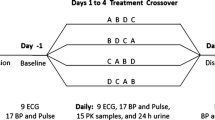Summary
7-3H-phenylephrine was given to 15 volunteers by a short-infusionn=4) or p.o. (10 volunteers, 1 patient with porto-caval anastomosis). Analysis of serum for free3H-phenylephrine and fractionation of urinary radioactivity was performed by ion-exchange and thin-layer chromatography. As almost the same3H-activity was excreted in urine after i.v. and p.o. administration, 86% and 80% of the dose respectively, complete enteral absorption can be assumed. A considerable difference was seen in the fraction of free phenylephrine, i.v. 16% of the dose versus p.o. 2.6%, which suggested reduced bioavailability. This was confirmed by comparison of the areas under the serum curve, which showed a bioavailability factor of 0.38. The result for the patient with porto-caval anastomosis was comparable to that in the normal volunteers. The biological half-life of 2 to 3h was comparable to that of structurally related amines, as were the total clearance of 2 1/h, and the volume of distribution of 340l. Metabolism to phenolic conjugates mainly after oral ingestion, and tom-hydroxymandelic acid after i.v. injection, again demonstrated thatm-hydroxylated amines are predominantly conjugated during the “first-pass” metabolism.
Similar content being viewed by others
References
Ahlquist RP, Levy B (1959) Adrenergic receptive mechanism of canine ileum. J Pharmacol Exp Ther 127: 146–149
Barger G, Dale HH (1910) Chemical structure and sympathomimetic action of amines. J Physiol (Lond) 41: 19–59
Besarab A, Silva P, Landsberg L, Epstein F (1977) Effect of catecholamines on tubular function in the isolated perfused rat. Am J Physiol 233: F39-F45
Borromeo-McGrail V, Bordiuk JM, Keitel H (1973) Systemic hypertension following ocular administration of 10% phenylephrine in the neonate. Pediatrics 51: 1032–1036
Bruce RB, Pitts JE (1968) The determination and excretion of phenylephrine in urine. Biochem Pharmacol 17: 335–337
Dost FH (1968) Grundlagen der Pharmakokinetik. Thieme Verlag, Stuttgart
Elis J, Laurence DR, Mattie H, Prichard BNC (1967) Modification by monoamine oxidase inhibitors of the effect of some sympathomimetics on blood pressure. Br Med J 2: 75–78
Fraunfelder FT, Scafidi AF (1978) Possible adverse effects from topical ocular 10% phenylephrine. Am J Ophthalmol 85: 447–453
Govier WC (1967) A positive inotropic effect of phenylephrine mediated through alpha adrenergic receptors. Life Sci 6: 1361–1365
Hengstmann JH (1976) Metabolic pattern and pharmacokinetic properties of phenolic sympathomimetic amines. Arzneim-Forsch (Drug Res) 26: 1254–1255
Hengstmann JH, Aulepp H (1978) Pharmakokinetik und Metabolismus von3H-Synephrin. Arzneim-Forsch (Drug Res) 28: 2326–2331
Hengstmann JH, Goronzy J (1980) Enterale Resorption und Bioverfügbarkeit von Norfenefrin. Arzneim-Forsch. (Drug Res) 30: 2164–2167
Hengstmann JH, Konen W, Konen C, Eichelbaum M, Dengler HJ (1974) The physiological disposition ofp-octopamine in man. Naunyn-Schmiedebergs Arch Pharmacol 283: 93–106
Hengstmann JH, Konen W, Konen C, Eichelbaum M, Dengler HJ (1975a) Bioavailability ofm-octopamine in man related to its metabolism. Eur J Clin Pharmacol 8: 33–39
Hengstmann JH, Weyand U, Dengler HJ (1975b) The physiological disposition of etilefrine in man. Eur J Clin Pharmacol 9: 179–187
Horvath SM, Knapp DW (1954) Hemodynamic effects of neosynephrine. Am J Physiol 178: 387–391
Innes IR, Nickerson M (1975) Norepinephrine, epinephrine and the sympathomimetic amines. In: Gilman A, Goodman LS (eds) The pharmacological basis of therapeutics. 5th ed. Macmillan, New York, pp 477–513
Kuschinsky G, Oberdisse K (1931) Die Kreislaufwirkungen des Meta-Sympatols. Arch Exper Pathol Pharmakol 162: 46–55
Leong LSK, Benfey BG (1968) Actions of phenylephrine on contractility and rate of rabbit atria. Pharmacologist 10: 206
Martinez TT, McNeill JH (1977) Cyclic AMP and the positive inotropic effect of norepinephrine and phenylephrine. Can J Physiol Pharmacol 279–287
Quebbemann AJ, Rennick BR (1968) Catechol transport by the renale tubule in the chicken. Am J Physiol 214: 1201–1204
Reinhardt D, Wagner J (1974) Beat-adrenolytic, antiarrhythmic and local anaesthetic effects of phenylephrine. Naunyn-Schmiedebergs Arch Pharmacol 284: 245–261
Riegelman S, Loo JC, Rowland M (1968) Concept of a volume of distribution and possible errors in evaluation of this parameter. J Pharm Sci 57: 128–133
Trendelenburg U, Muskus A, Flemming WW, Gomez Alonsa de la Sierra B (1962) Modification by reserpine of the action of sympathomimetic amines in spinal cats: a classification of sympathomimetic amines. J Pharmacol Exp Ther 138: 170–180
Author information
Authors and Affiliations
Rights and permissions
About this article
Cite this article
Hengstmann, J.H., Goronzy, J. Pharmacokinetics of3H-phenylephrine in man. Eur J Clin Pharmacol 21, 335–341 (1982). https://doi.org/10.1007/BF00637623
Received:
Accepted:
Issue Date:
DOI: https://doi.org/10.1007/BF00637623



